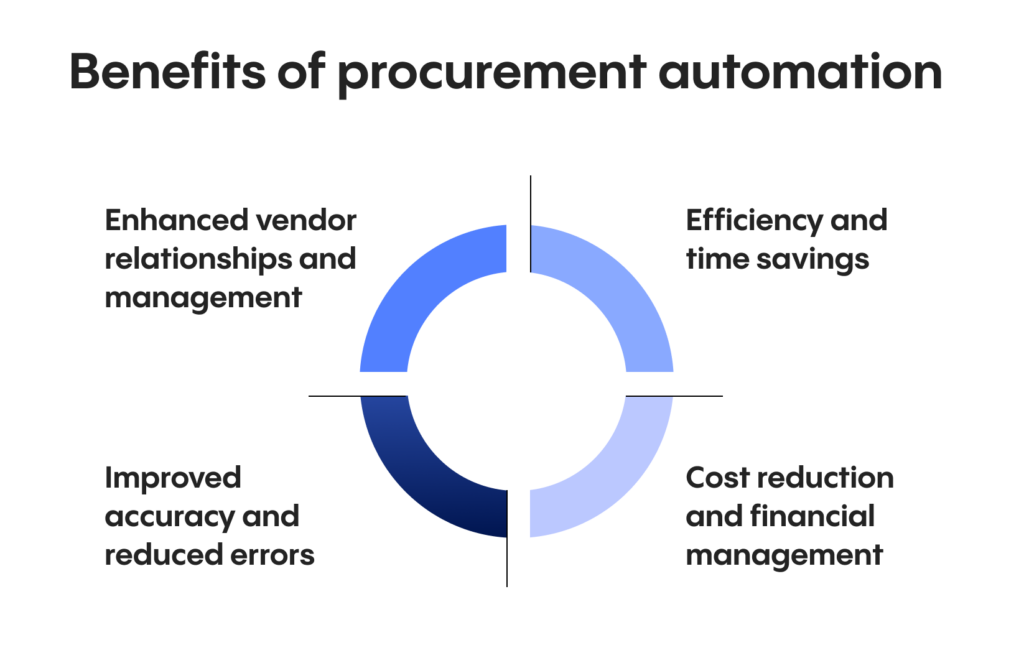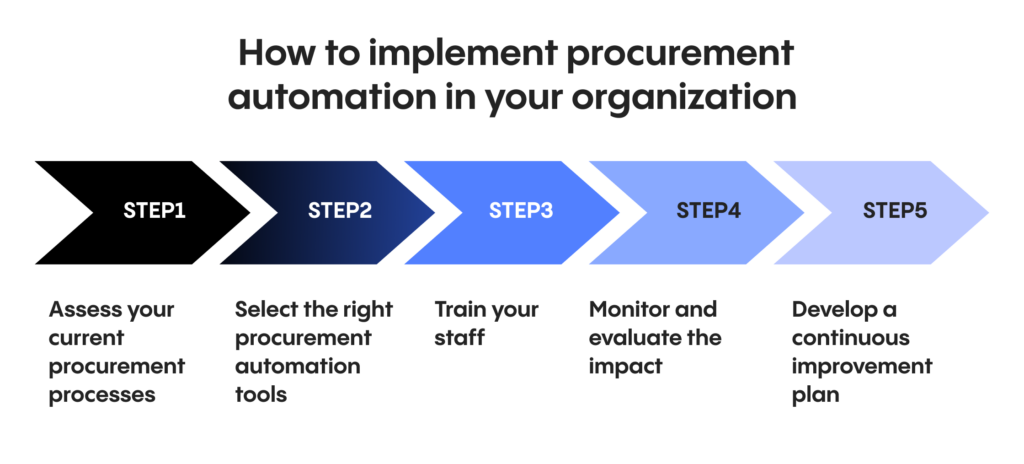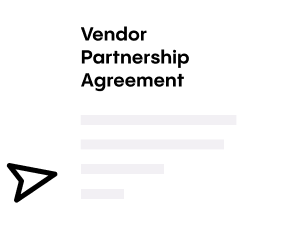Procurement Automation: The Ultimate Guide
Table of contents
- What is procurement automation?
- Benefits of procurement automation
- Key components of procurement automation systems
- Key technologies driving procurement automation
- How to implement procurement automation in your organization
- Key criteria for selecting procurement automation vendors
- Key challenges in implementing procurement automation
- Best practices in procurement automation
- The role of procurement automation in risk management
- The future of procurement automation
- Conclusion: Procurement automation equips your organization for the future
Today, businesses are recognizing the urgent need for procurement automation more than ever before. This approach transforms manual processes into automated procurement contract management workflows, redefining how companies manage their procurement tasks.
By automating, companies see significant gains in efficiency and time savings. Financial management becomes more robust with cost reduction strategies, and the accuracy of operations improves, reducing errors. Another key advantage is the positive impact on vendor management and supplier relationships, as automation provides more accurate and timely interactions.
Here, we’ll provide you with a comprehensive understanding of procurement automation, its benefits, key components, and emerging trends, helping you to make informed decisions for your procurement contracts. Let’s jump straight in with a clear definition of the term.
What is procurement automation?
Procurement automation is the application of technology to digitally generate purchase orders, process invoices, and manage supplier relationships automatically. This transformation allows procurement teams to focus more on strategic tasks rather than repetitive, time-consuming ones.
The key distinction with procurement automation is its specific focus. In contrast to general contract automation, procurement automation zeroes in on specific procurement activities such as supplier management, contract management, and purchase requisit ion. This targeted approach not only increases efficiency, but also provides detailed insights on your entire supply chain.
Benefits of procurement automation
Procurement automation brings a multitude of benefits to your business, by revolutionizing how you handle procurement processes.

Efficiency and time savings
Automation significantly speeds up procurement processes. By digitizing purchase orders and invoice processing, your team spends less time on paperwork and more on strategic initiatives. This shift not only speeds up operations but also frees your staff to focus on tasks that add more value to your business.
Cost reduction and financial management
One of the most tangible benefits is cost savings. For example, automation minimizes the risk of over-ordering or duplicating orders. It also streamlines the procure-to-pay process, leading to better financial management and control over spending.
Improved accuracy and reduced errors
Manual procurement processes are prone to human error. Automation introduces precision in order requisitions, invoice processing, and contract management, significantly reducing errors. This accuracy ensures more reliable data for decision-making and reporting.
Enhanced vendor relationships and management
Automated systems provide real-time data on supplier performance and contract compliance. This information enables you to manage supplier relationships more effectively, ensuring you work with the best vendors and fostering stronger partnerships.
Beyond these core benefits, procurement automation also enhances compliance and audit readiness, provides valuable insights through data analytics, and supports scalability as your business grows. By automating procurement tasks, you position your company for greater operational success and long-term sustainability.
Key components of procurement automation systems
Procurement automation systems consist of several key components, each playing a vital role in streamlining your procurement processes.
Electronic data interchange (EDI)
EDI allows you to exchange procurement documents electronically with suppliers. This component speeds up transactions, reduces paperwork, and increases accuracy by automating the exchange of critical documents like purchase orders and invoices.
Cloud-based procurement solutions
Cloud-based solutions offer accessibility and scalability. They allow you to manage procurement processes from anywhere, providing real-time data and insights. These solutions also adapt easily as your business needs change, making them a versatile tool for growth.
E-procurement software
E-procurement software centralizes your procurement activities. It automates tasks like supplier selection, contract management, and purchase order creation, making your procurement process more efficient and transparent.
Supplier management tools
These tools help you manage supplier relationships effectively. They help you track supplier performance, contract compliance, and risk, ensuring you collaborate with the best suppliers and maintain high standards in your supply chain.
Analytics and reporting tools
Analytics and reporting tools offer deep insights into your procurement activities. They help you understand spending patterns, identify cost-saving opportunities, and make informed decisions based on data-driven insights.
Beyond these components, consider the importance of user-friendly interfaces, integration capabilities with existing systems, and robust security measures. These factors contribute to the effectiveness and adoption of procurement automation systems in your business.
Key technologies driving procurement automation
Procurement automation is driven by several key technologies, each playing a pivotal role in enhancing procurement processes.
Cloud-based document solutions
Cloud-based document automation platforms enable you to access essential business documents and reporting tools from anywhere, facilitating collaboration and smarter decision-making. Concord, for instance, provides a comprehensive cloud-based platform for contract management, enhancing the efficiency and effectiveness of your procurement operations. E-procurement software can also be helpful.
Data analytics and big data
Unlike earlier data forms, big data encompasses a vast volume of data from various sources, both structured and unstructured. This diversity allows for more nuanced analysis, uncovering insights that were previously inaccessible — enabling you to make data-driven decisions, optimize your procurement strategy, and identify areas for cost savings and efficiency improvements.
Software integrations
Integrations are crucial for creating a seamless procurement ecosystem. They enable different software systems to communicate with each other, keeping data flowing smoothly across your procurement, finance, and contract management software systems.
Internet of things (IoT)
The internet of things (IoT) plays a significant role in procurement by enhancing supply chain visibility and monitoring. IoT devices can track inventory levels, shipment status, and supplier performance in real time, providing actionable insights to improve procurement efficiency.
When implementing these technologies, consider their compatibility with your current systems and their potential to evolve as your procurement needs change. Also, focus on technologies that prioritize data security and user experience, as these factors are critical for successful adoption and operation.
How to implement procurement automation in your organization
Implementing procurement automation in your business is a strategic process that requires careful planning and execution. Here’s a step-by-step guide.

Step 1: Assess your current procurement processes
Start by thoroughly evaluating your existing procurement processes. Identify areas where manual processes dominate, understand the bottlenecks, and pinpoint where automation can bring the most value. This assessment forms the basis for a tailored automation strategy.
Step 2: Select the right procurement automation tools
Choose automation tools that align with your business needs and goals. Consider factors like scalability, ease of use, integration capabilities, and specific features that address your unique challenges. The right tools should not only automate processes but also provide insights and analytics to drive continuous improvement.
Step 3: Train your staff
Training and change management are crucial for successful implementation. Educate your staff about the new systems and processes, emphasizing the benefits and changes in workflow. Effective training ensures smoother transition and higher adoption rates.
Step 4: Monitor and evaluate the impact
Once implemented, continuously monitor and evaluate the impact of procurement automation. Assess metrics like process efficiency, cost savings, and supplier performance. Regular evaluation helps you fine-tune the system and realize the full potential of automation.
Step 5: Develop a continuous improvement plan
It’s also worthwhile to consider the importance of data security and compliance in your automation tools. Ensure your chosen solutions comply with relevant regulations and industry standards. Also, factor in future scalability to accommodate your business’s growth and evolving needs.
Key criteria for selecting procurement automation vendors
Choosing a procurement automation vendor directly affects your business’s efficiency, cost management, and supply chain relationships. Here are some key criteria to look for.
Compatibility with existing systems
Choose a vendor whose solutions integrate seamlessly with your current systems. Compatibility reduces the risk of operational disruptions and ensures a smoother transition. Assess how well the vendor’s tools can sync with your existing software to maintain workflow continuity.
Scalability and future growth
Opt for a vendor that offers scalable solutions. As your business grows, your procurement needs will evolve. A scalable solution adapts to increased demands, supporting your business’s growth without the need for constant system upgrades or replacements.
Customer support and service
Quality customer support is vital. Select a vendor known for providing a reliable and accessible customer success team. This support is crucial for resolving any issues quickly and efficiently, minimizing downtime and maintaining operational continuity.
Cost-effectiveness
Evaluate the cost-effectiveness of the vendor’s solutions. Consider not only the initial investment but also the long-term value. A cost-effective solution offers a balance between price, features, and performance, delivering value without compromising on quality or functionality.
Data security and compliance
Data security is mission-critical in procurement automation. Choose a vendor that adheres to strict data security standards and complies with relevant regulations. This commitment to security protects your sensitive procurement data and helps maintain your reputation and trustworthiness.
Also consider the vendor’s track record, the user-friendliness of their solutions, and the flexibility of their software. Look for vendors who continuously update and improve their products to keep pace with technological advancements and changing industry needs.
Key challenges in implementing procurement automation
Implementing procurement automation in your business involves overcoming a variety of key challenges. Here’s how to address some of the most common.
Integration with existing systems
Integrating new automation tools with your existing software and infrastructure can be complex. You may face compatibility issues or disruptions in current processes. To address this, opt for solutions that offer flexible integration capabilities. Working with IT specialists to create a phased integration plan can ease the transition, minimizing disruptions.
Change management and employee adoption
Managing organizational change and ensuring staff adapt to new technologies is often a hurdle. Overcome this by involving your team early in the decision-making process. Offer comprehensive training and support, and communicate the benefits clearly to encourage adoption. Appointing change champions within your team can also facilitate smoother transition.
Data quality and management
Maintaining data accuracy and quality in automated systems is crucial. Inaccurate data can lead to flawed decision-making. Implement robust data governance policies and conduct regular audits to maintain high data quality standards. Utilize tools that offer real-time data validation to prevent errors at the source.
Cost and ROI considerations
Addressing the financial aspects, including the initial investment, ongoing costs, and return on investment, is critical. To tackle this, conduct a thorough cost-benefit analysis before implementation. Choose solutions that offer scalability and flexibility to maximize your return on investment.
Security and privacy concerns
It’s crucial to prioritize data security and privacy in procurement automation systems. To manage this challenge, regularly update your security protocols and conduct periodic security audits. It also helps to educate your team about best practices in data security to create a culture of awareness and compliance.
By addressing these challenges head-on, you’ll lay a strong foundation for a successful implementation of procurement automation in your business.
Best practices in procurement automation
Adopting best practices in procurement automation can significantly enhance the efficiency and effectiveness of your business operations.
Develop a clear strategy
Craft a well-defined strategy for your procurement automation. This involves setting clear goals, understanding your procurement needs, and aligning the automation process with your overall business objectives. A strategic approach helps in creating a roadmap for successful implementation and long-term benefits.
Prioritize scalability and flexibility
Choose procurement automation solutions that offer scalability and flexibility. Your business needs will evolve, so it’s important that your automation tools can adapt and scale accordingly. This flexibility supports continuous growth and changes in the business environment.
Plan for data security and compliance
Pay close attention to data security and compliance. With procurement involving sensitive information and transactions, your automation tools must adhere to industry standards and regulations. This protects your business from data breaches and legal complications.
Manage vendors proactively
Implement effective strategies for vendor selection and management. Use automation tools to assess vendor performance, compliance, and contract risk. Effective vendor management ensures you work with the best suppliers and maintain high standards in your supply chain.
Also, focus on continuous training and support for your staff to maximize the benefits of procurement automation. Keep abreast of emerging technologies and trends in procurement to stay competitive. Regularly review and update your procurement processes and systems to ensure they meet your business requirements and industry best practices.
The role of procurement automation in risk management
Procurement automation plays a central role in risk management, enhancing the safety and reliability of your procurement processes. Here are some key areas where it’s most impactful.
Identifying and mitigating risks
Automation tools help you identify procurement risks early. They analyze patterns and trends in your procurement data, flagging anomalies that could indicate risks such as supplier issues or price volatility. This early detection allows you to take proactive measures, reducing the potential impact on your business.
Compliance monitoring
Automation streamlines compliance with regulations and policies. Automated systems keep track of regulatory changes and ensure your procurement activities align with these requirements. They also maintain detailed records, making it easier to demonstrate compliance during audits.
Supply chain resilience
Automation contributes to stronger supply chain resilience. By providing real-time data on supplier performance and market conditions, it helps you anticipate and respond quickly to supply chain disruptions. This agility is key to maintaining steady operations under various market conditions.
Vendor risk assessment
Procurement automation leverages tools for comprehensive vendor risk assessment. These tools evaluate and monitor the financial health, reliability, and performance of your suppliers, helping you make informed decisions and mitigate risks associated with vendor relationships.
Contract management and control
Automated contract management tools can help ensure that all your procurement contracts adhere to agreed terms and conditions. It flags contracts nearing expiration or renewal, helping you maintain control over your contractual obligations and avoid potential legal risks.
Financial risk analysis
Procurement automation tools also include financial risk analysis features. They provide insights into spending patterns, helping you avoid budget overruns and make cost-effective procurement decisions.
By integrating procurement automation into your risk management strategy, you not only streamline your procurement processes but also strengthen the overall risk posture of your organization.
The future of procurement automation
Upcoming developments in procurement automation will offer targeted enhancements in the areas of efficiency, data security, and global supply chain management.
AI and machine learning
Artificial intelligence (AI) and machine learning are revolutionizing procurement automation. They bring predictive analytics and intelligent decision-making to the table, enabling you to anticipate market changes, optimize procurement strategies, and automate complex tasks with greater accuracy.
Advanced analytics
Advanced analytics will take procurement data analysis to new heights. By processing vast amounts of data, these tools will provide deeper insights into spending patterns, supplier performance, and market trends, enabling more strategic procurement decisions.
Global business changes
As global business dynamics evolve, procurement automation must adapt. It will play a crucial role in managing global supply chains, navigating regulatory changes, and mitigating risks associated with international procurement.
Integration of sustainable practices
Sustainability is becoming a critical aspect of procurement. Future automation tools will likely incorporate sustainability metrics, helping businesses make procurement decisions that align with their environmental and social responsibilities.
Blockchain technology
Blockchain technology is set to enhance transparency and security in procurement processes. It will enable more secure and efficient transactions, improve traceability in the supply chain, and reduce fraud and errors.
In navigating these trends, focus on flexibility and adaptability in your procurement automation solutions. Keep a lookout for how they can integrate into your existing systems to drive ongoing improvement and resilience in your procurement processes.
Conclusion: Procurement automation equips your organization for the future
Your organization can reap substantial rewards by adopting procurement automation. It not only streamlines processes but also offers strategic advantages in supplier management and financial planning.
As you embark on this journey, focus on selecting the right tools, training your team effectively, and staying adaptable to technological advancements. This approach will help your business remain competitive and efficient in an evolving market.





